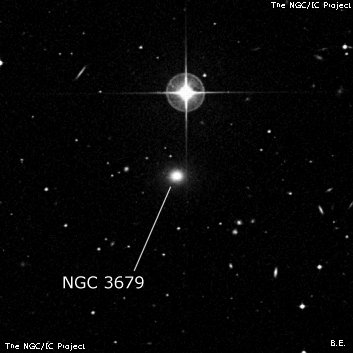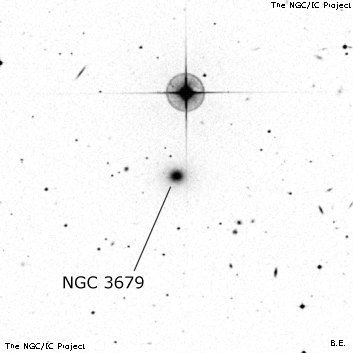NGC/IC Project Restoration Effort
(This is a very very beta version)
NGC3679


Basic Information
Location and Magnitude
Right Ascension: 11:21:47.9
Declination: -5:45:28
Constellation: LEO
Visual Magnitude: 13.6
Historic Information
Discoverer: Herschel W.
Year of discovery: 1784
Discovery aperture: 18.7
Observational
Summary description: eF, cL, R, r (v near vB *)
Sub-type: E2
Corwin's Notes
=====
NGC 3679 and NGC 3915 are H III 112 and III 113, both found the night of
24 April 1784, and both referred to the same star, 74 Leo (SAO 138102). There
is nothing at either position reduced from WH's offsets from this star. The
other brighter objects found on that night (N4697 and N4941 = H I 39 and 40;
and N4593, N4602, and N4989 = H II 183,4,5) were all compared with 51 Virginis
and are close enough to the derived positions to identify without problems.
JH, however, noted that Mayer 510 (SAO 138798), taken later in the same sweep,
is a better comparison star. He determined the positions of the two objects
given in GC using this star, and Dreyer adopted these positions for NGC, too.
He also discusses the problem of the comparison stars in a note to NGC, as
well as in the Notes to his 1912 edition of WH's papers. Unfortunately, there
are still no nebulae at either position.
At this point, it's worth noting that, regardless of which star is used, WH's
relative position between the two objects is the same: 24 minutes 12 seconds
in RA and 49 arcmin in Dec. This suggests that we should look for objects
matching his descriptions separated by these amounts.
Now, other observers begin to cloud the picture. Dreyer credits Peters with
an observation of N3915. But as with WH's observation, there is nothing at
Peters's position (he says that he determined it by plotting the object on
charts of his own construction). His note for N3915 reads, "AR in GC from
15 sec to 20 sec too small, and also the declination differs rather much.
The nebula is vL, and not eS, as H. III. 113 has it." Just what nebula he
saw is something of a mystery. It could have been IC 2963, but Peters's RA is
over a minute off, and his Dec is nearly 2 arcmin off as well.
Another object sometimes suggested as NGC 3915 is IC 738. However, that is
about 1m 40s and 29 arcmin off Peters's position, so seems an unlikely
candidate. There are, however a couple of galaxies that would correspond to
NGC 3679 at approximately the correct position, assuming WH's difference in
position (24min 12sec and 49 arcmin). The brighter is MCG -01-29-017, the
fainter is 2MASX J11244816-0531565. Neither, however, has a bright star
nearby that would match WH's description for NGC 3679.
Spitaler has a series of good micrometric observations of nebulae which
includes N3679. He makes it the object we now call MCG -01-29-021 = Markarian
1294. But this is nearly 15 arcmin away from the nearest of WH's positions,
and does not match his description of being "very near a very bright star."
Dreyer makes a note of Spitaler's observation in his IC1 Notes, and again in
the 1912 Scientific Papers Notes.
So, we're left with a puzzle: what did WH and Peters see? Let's assume that
WH's descriptions are good [for N3679 he says, "eF, cL, R, r (v nr vB *)"
and for N3915, "eF, eS w 240. 2 vS sts and nebulosity."]. The only objects
in the area matching these descriptions are MCG -01-29-012 (at 11 19 15.35,
-05 29 00.6; B1950.0 from GSC) which has SAO 138156 about 2 arcmin to the
north, and the previously uncatalogued galaxy at 11 44 22.20, -04 54 35.4
(again, GSC for B1950.0) which has a somewhat fainter star superposed about 15
arcsec to the southwest of its bright core. The relative positions of these
two galaxies in 1784 was 25 min 04 sec, and 35.3 arcmin, not wildly off WH's
"observed" offsets -- but not very close, either.
In the end, I've taken MCG -01-29-012 and the uncatalogued object as perhaps
the two that WH saw. It's clear, however, that there are unexplained large
errors in WH's offsets for these two objects. So, these identifications are
quite uncertain, and could well be completely wrong.
-----
In July 2016, I looked at WH's sweep. Here is what he has to say about this
object (CH's fair copy in the Herschel Archives with her reduced position for
1800 also given):
cL, excessively F, R, r; just preceding, and very near a B st. The
nebulosity touches the star. There is so much moon light that I do not see
it satisfactorily, and am, even not without some doubts as to the reality,
but must defer the verification till [sic] a darker night. Mayer's 510 p
1h 1' 48" s 1d 20' RA 11h 15' 49" PD 94d 50'
CH gives the position of Mayer's 510 as 12 17 37.1, 93 30 20 (NPD) for 1800.
This becomes 12 27 53.5, -04 36 50 for J2000 which identifies the star as
FT Vir = HD 108506. As noted above, there is nothing in WH's offset from this
star.
Going through the sweep, I see several other objects referred to HD 108506,
and I notice that the RA corrections (to WH's clock readings) for this sweep
(and the next on the same night) vary by over a minute of time from +4m 32s to
+5m 47s, with that for HD 108506 being +4m 49s. The NPD corrections also
differ with one group of five stars close to +92d 30s, and two others --
including HD 108506 -- being +93d 00s. So, WH's zero points through these
sweeps were inconsistent.
Finally, I note that he has the bright star just following the nebula and
"touching" it, while the star near MCG -01-29-012 is two arcminutes south of
SAO 138156. I would not say that the nebula "touches" the star, and the
direction certainly does not match WH's description. The star's proper motion
is small enough in both coordinates that it would not significantly change its
position relative to the galaxy over the 216 years between WH's observation
and 2000 (to which the proper motions have been reduced).
So, the puzzles remain. I'll be interested in seeing what Wolfgang has to say
about this in his evaluation of WH's observations. In the meantime, I've
changed the colon on the identification of NGC 3679 to a question mark to more
accurately reflect the uncertainty in WH's observation.
Steve's Notes
=====
NGC 3679
18" (3/19/04): fairly faint, small, elongated 5:2 N-S, 0.7'x0.3', fairly even surface brightness. Three mag 14 stars are within 2'. Located 4.6' SSE of a mag 10 star. The NGC identification is very uncertain and NGC 3679 may apply to MCG -01-29-012.



